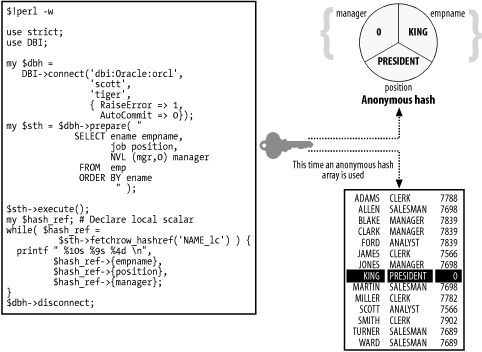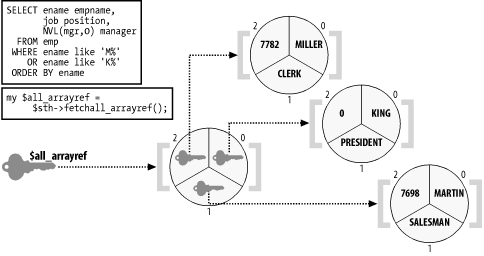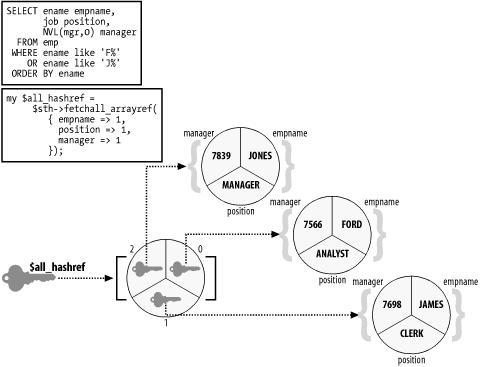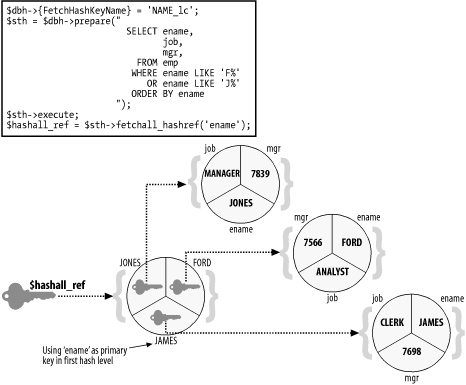Statement Handle Methods
Statement Handle MethodsBefore we execute prepared statements, we can bind IN and OUT parameters using the methods described in this section. bind_paramThe bind_param method binds parameters to SQL statements. Placeholders are numbered from 1 upwards. For example: $sth = $dbh->prepare("SELECT * FROM emp WHERE ename LIKE ? OR ename LIKE ? "); $sth->bind_param(1, "MILLER"); $sth->bind_param(2, "K%"); $sth->execute; You can also use named parameters, described at the end of the next section. bind_param_inoutThe bind_param_inout method, available under DBD::Oracle , helps us with PL/SQL. This method allows us to call procedures with OUT parameters. Let's see how it works.
As an alternative to using question marks, you can also use named bound parameters with DBD::Oracle . In the following example, the procedure has been predefined like this: CREATE OR REPLACE PROCEDURE squarer ( in_number IN NUMBER, inout_result IN OUT NUMBER ) IS BEGIN inout_result := POWER(in_number, 2); END; Perl DBI code to use this procedure would look something like this: my $in_number = 3; my $inout_result; $sth = $db->prepare(q{ BEGIN squarer(:in_number, :inout_result); END; }); # We bind here, then execute the call. $sth->bind_param(":in_number", $in_number); $sth->bind_param_inout(":inout_result", $inout_result, 1); $sth->execute; print $inout_result; executeWe've already strewn the execute method liberally throughout this chapter. It's used to execute prepared statements. It returns an undef on failure, or the number of rows affected if this information can be determined. Otherwise , it returns -1. $rv = $sth->execute; If bind variables are being used, we can send these in as an array, rather than binding them all explicitly with separate bind_param calls: $rv = $sth->execute( @bound_values ); fetchrow_arrayThe fetchrow_array method fetches rows from an array. A popular FETCH command is illustrated in Figure B-2. Figure B-2. A simple fetchrow_array example Let's see what's going on here.
fetchrow_arrayrefGoing a step beyond fetchrow_array , the fetchrow_arrayref method is more efficient because instead of copying data rows into a local array, it provides a reference to the row of data already stored within the driver. It's a fairly straightforward operation to drill down from the reference into this remote array, as shown in Figure B-3. Figure B-3. fetchrow_arrayref fetchrow_hashrefIn a similar manner, the fetchrow_hashref method (shown in Figure B-4) returns a reference to an anonymous hash for each row. This time the data is keyed on column name , rather than numeric index. It's best to give this method an optional string parameter of either NAME_uc or NAME_lc to ensure that column names are always in a preferred case; otherwise, they may be in mixed case, especially if you're using Perl DBI in a portable manner across different database types. Figure B-4. fetchrow_hashref fetchall_arrayrefInstead of accessing data one row at a time, you can get a single reference to access all of the data in one go (if you have the available memory). Use the fetchall_arrayref method, as shown in Figure B-5, which demonstrates the default use of fetchall_arrayref . A single key accesses a first-level array composed of reference keys to second-level arrays. There is one of these for each row of data found by the SELECT statement. Figure B-5. fetchall_arrayref with array batches Figure B-6 demonstrates a variation on this theme. An optional hash marks out the various column names required. This transforms the second-level arrays into hashes, accessed by column name rather than numeric index. Figure B-6. fetchall_arrayref with hashes fetchall_hashrefThe fetchall_hashref method can only be used with SELECT statements containing unique key data combinations, such as single-column primary keys. This method creates a first-level hash possessing as many index keys as there are uniquely keyed rows. We can then drill down from this hash into second-level hashes, which contain all of the row data by column name. Figure B-7 illustrates the use of this method. Figure B-7. fetchall_hashref with its key requirement finishThe finish method deactivates an active SELECT statement handle, thus causing any pending unfetched data to be discarded. This can free up resources in the server, especially for large GROUP BY or ORDER BY queries. It is rarely used, however, because statement handles deactivate anyway after a last row is fetched . Nevertheless, you may want to use this method if you're only fetching a fixed number of rows from a statement (see the selectrow_array method mentioned later). You should also finish active statements before disconnecting from a database: $rc = $sth->finish; rowsThe rows method holds the number of rows processed by the statement; it returns -1 if it is unable to determine a figure. When you use this method with a SELECT statement, wait until all of the rows have been fetched before calling it, to get accurate results: $rv = $sth->rows; bind_colFor a more efficient way to access data, you can use the bind_col method and its partner, bind_columns . We simply bind in the variables we need to associate selected columns with, before calling a simple fetch command: Let's examine the following code: $sth = $dbh->prepare(" SELECT deptno, dname, loc FROM dept "); $sth->execute; $sth->bind_col(1, $deptno); # Notice the use of referencing! :) $sth->bind_col(2, $dname); $sth->bind_col(3, $loc); while ( $sth->fetch ) { # Simple fetch printf "%2d %14s %13s \n", $deptno, $dname, $loc; } When executed, this prints the following: 10 ACCOUNTING NEW YORK 20 RESEARCH DALLAS 30 SALES CHICAGO 40 OPERATIONS BOSTON bind_columnsUsing the bind_columns method, you can shrink those three bind_col lines into a single bind_columns call. Simply ensure that you have the same number of variables in the bind_columns call as there are fields to be selected, and also make sure you then get them in the right order. For example: $sth->bind_columns($deptno, $dname, $loc); # List of references dump_resultsThis prototyping method fetches all the selected rows out from a statement, as comma-separated values, and prints them to STDOUT: $sth->dump_results; |
EAN: 2147483647
Pages: 137